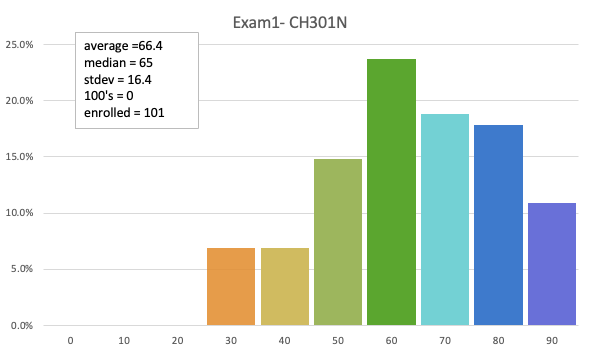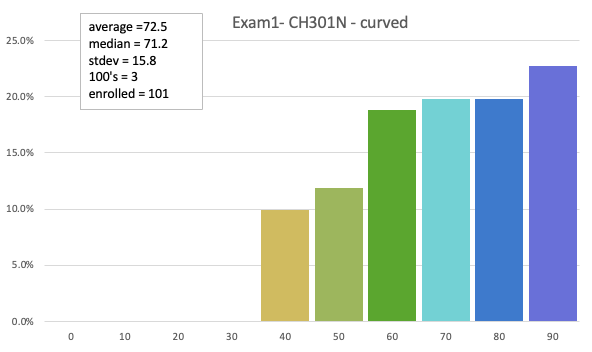Exam 1
Tuesday 9/13
WEL 3.502
63.7 avg
🔑 Here are all the KEYS to Exam 1
Learning Outcomes
Students will know...
how to count stuff
how to mathematically convert from one type of unit to another utilizing a set of conversion factors
the names, formulas, and physical state of the first 10 alkanes
Know which elements exist as diatomic molecules
the MAIN Metric Prefixes for Chemistry Class as listed in section 10.2 of chembook - it's the last table there
how to fully balance a chemical reaction and identify the coefficients
how to do composition stoichiometry calculations - figuring out the percent of a specific element in a given compound
how to do reaction stoichiometry calculations converting moles to moles and also moles to grams and grams to grams or anything else
how to predict product amounts when given arbitrary amounts of reactants - limiting reactant problems (like #20 on HW01)
the same outcomes as the two previous ones but with gas moles using the ideal gas law to get pressure or volume of the gas reactants.
the 3 primary components and their percentages of dry air
how those percentages change when humid air is used
the 6 primary pollutants in our air - know names and formulas and/or abbreviations for them
the primary sources/causes of those pollutants
what methods are in place to help curb the amounts of these pollutants in air
how to calculate various gas law values - P, V, T, and n according to the ideal gas law and associated laws
how to convert pressure of a gas into number (mole) density
what partial pressure is and how to calculate it.
how to get mole fraction from partial pressure and total pressure and vice versa
how to use the pressure and identity of a gas to calculate its mass density
how to convert mass density and pressure into the molecular weight of a gas
anything else we learned and did in class, on HW, that I forgot here
More Help on Exam 1
Jimmy Wadman's* Help Videos on Exam 1 topics.
*Jimmy Wadman was a longtime TA/Specialist for the UT Chemistry Department. His videos are meaningful and clear. Have a look if you need a new/different take on all this. We are all teaching the same thing. We each have our own "style".
Formulas YOU should know
The Ideal Gas Law (IGL):
\(PV=nRT\)
Gas Laws "contained" in the IGL:
Boyle's Law: \(P_1V_1 = P_2V_2\) (constant n , T )
Charles' Law: \(\displaystyle{V_1\over T_1} = {V_2\over T_2}\) (constant n , P )
Avogadro's Law: \(\displaystyle{V_1\over n_1} = {V_2\over n_2}\) (constant P , T )
Gay-Lussac's Law: \(\displaystyle{P_1\over T_1} = {P_2\over T_2}\) (constant n , V )
Inflate a Tire Law: \(\displaystyle{P_1\over n_1} = {P_2\over n_2}\) (constant V , T )
Nobody Does This Law: \(n_1T_1 = n_2T_2\) (constant P , V )
(note that you will be tested on the actual relationships of the physical properties and not the scientist's names)
and because density (ρ ) is m/V and molar mass (M ) is m/n , then you also know the molar mass of an ideal gas via:
\[{M={\rho RT\over P}}\]
Dalton's Law of Partial Pressures
mole fraction of gas A: \(x_{\rm A}=P_{\rm A}/P_{\rm total}\)
Here are two practice problem sets for you to work on and get some experience working through these types of problems.
Composition Stoichiometry Extra Practice.pdf HTML version
Gas Law Stoichiometry Extra Practice.pdf HTML version
Sorry, but we do not have any answer keys to these problem. Talk with other students about the problems and try to reach a correct conclusion/answer.
LINK to that page.
Exam protocol All you need to know about HOW to take our in-class exams. 

There is even MORE great practice problems (with keys) and helpsheets on the gchem site in Chapter 1 there under "Additional Content > Helpsheets and Worksheets". Here's a direct LINK to that page.